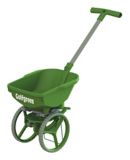

Milorganite can be used throughout your yard-on lawns, shrubs, trees, flowers, and vegetables-so you don’t have to worry about accidentally damaging surrounding plants while fertilizing your lawn. It won’t burn your lawn, so you don’t have to worry much about over application. Milorganite is very forgiving compared to synthetic fertilizers or those that contain herbicides. The best way to ensure you’re applying the proper amount of Milorganite is to calibrate your spreader. Many variables impact your spreader’s setting to reach optimal application rates, including the type, age, and condition of your spreader, as well as the rate at which you walk. Use spreader settings and application rates as guides. You just want the setting number, right? Unfortunately, each spreader is slightly different and so are you. Most homeowners don’t want to calibrate their spreader to discover the correct setting. Make sure to clean up any product from hard surfaces so it doesn’t end up in waterways. This isn’t a concern when using Milorganite, as it can be used on lawns, flowers, shrubs, and vegetables. This is a problem if you’re applying an herbicide, which would be detrimental if it got into your flower bed.
#SCOTTS STANDARD SPREADER FOR LIME MANUAL#
Check the spreader manual for tips on how far various types of fertilizers are thrown. Broadcast spreaders naturally distribute less product toward the edge of its broadcast range. The rate you walk and the spreader’s hole size impact how much product is distributed. Broadcast spreadersīroadcast spreaders distribute fertilizer in a fan-like pattern in all directions and cover a wider area per pass than drop spreaders. Less product will end up on your driveways, walks, and paths.ĭrawback: Drop spreaders cover a smaller area of lawn per pass compared to broadcast spreaders, which means it’ll take a bit more time to fertilize your lawn.Product distribution generally not impacted by the wind.Easy to navigate around obstacles and tight spots.

Works well for smaller lawns, under 5,000 sq ft.The rate at which you walk directly impacts how much product is distributed. It’s important that you overlap wheel marks to ensure the entire lawn has been covered. Drop spreadersĭrop spreaders are very accurate as they distribute even rows of fertilizer exactly where you want it. Selecting the right spreader for you depends on your lawn and preferences. All spreaders have a hopper to hold the product and an adjustable opening to control the volume of fertilizer or seed being distributed. There are two types of broadcast spreaders: walk-behind and hand-held. There are two types: drop and broadcast, also known as a rotary spreader. Spreaders are used to evenly distribute fertilizer and grass seed across your lawn. Fertilizing your lawn? Use a Correctly Calibrated Spreader By Jaime Staufenbeil - Milorganite Agronomist


 0 kommentar(er)
0 kommentar(er)
